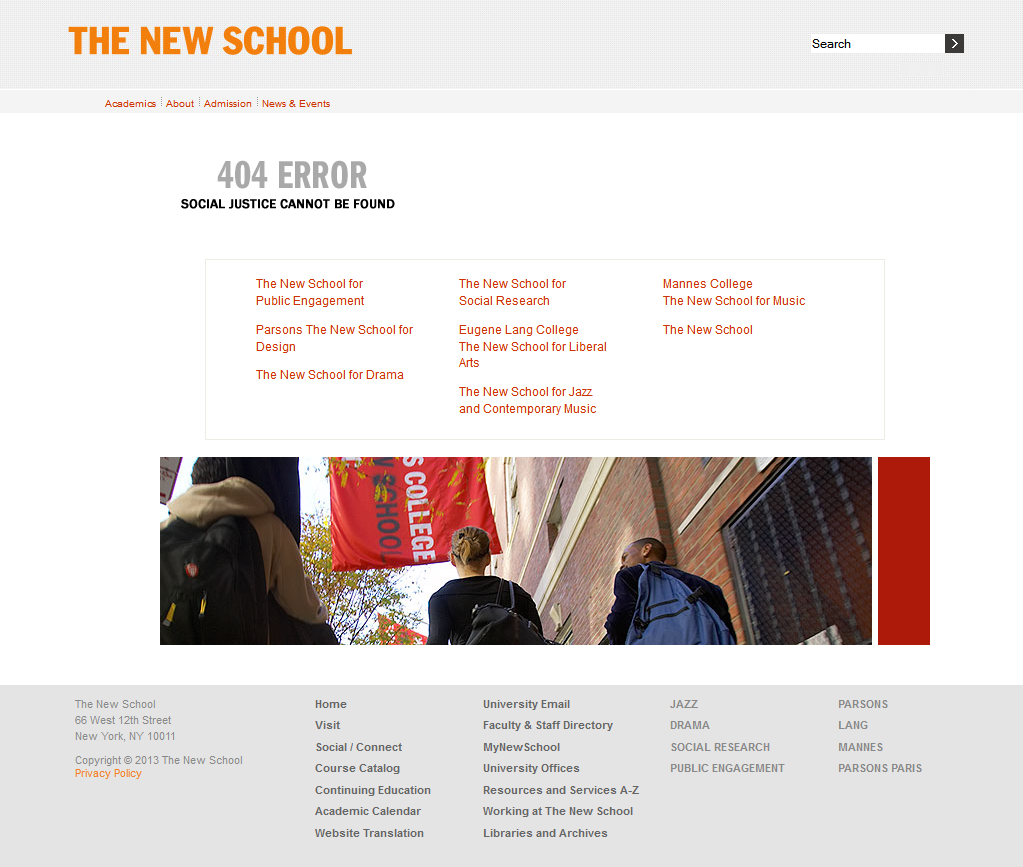
Text for TNS Art Exhibit
There are many practices within The New School that are cause for offense, but manifestations of institutional dissent are less clear. We could recall campus occupations by students, of which three have occurred since 2008, but such considerations exclude the majority of our community. What affects everybody, I wondered? Of course! There is one thing which represents the official face and party line of The New School and with which everyone—student, staff, faculty and public alike—has numerous encounters: our website.
As someone who uses our website as a student, an employee, an occasional professor, and as an information finder, my experience is one of consistent frustrations. These include the way social justice issues are portrayed—or excluded—in the content of the site, the way in which our institutional history is distorted and projected into the future as a sales gimmick, the arbitrary focus on flashy—or gaudy—aesthetics over usability, and the growing gap between branded mythos projected to the world and our lived reality. The following short anecdotes highlight the twin themes of offense and dissent based on my own experiences on www.newschool.edu.
Last year I was hired as a student RA as part of a divisional initiative at NSSR to revamp department websites, with the goal of improving the pages featuring Ph.D. students on the job market, or what we call “Hire a Ph.D.” While tracing how a prospective visitor would get to this page, I came across the splash page for the Politics department. The photo advertising our MA/Ph.D program shows Neil Grabois, former Dean at Milano, part of the New School for Public Engagement, an entirely different division of the school, who is not even affiliated with The New School now. While such an inconsistency would not be evident to a visitor, it manifests the administrative disregard that exists between the actual people in these programs and those curating the official image—a NSSR graduate program is advertised with people from another division (NSPE) who aren’t even part of the University any longer—but no one notices or cares.
Similarly, our website is evasive on the question of social justice. As a recent member of the Social Justice Committee (SJC), and for the former Student Co-chair, I have tried to support social justice activism on campus. One of my ongoing frustrations is that even as social justice becomes part of Town Hall talking points and branding tools for the Communications office to show how “tolerant” of diversity the University is, there are no serious steps to address the institutional racism, sexism, and other forms of oppression in and out of the classroom that many folks continue to face year after year. For example, while doing research on how “social justice” is presented in official University media, I did an experiment using the University RSS news feeds. While we talk a lot about our progressive legacy, civic engagement, social innovation and justice, our party line tells a different story, as the visualized absences of justice made clear.
How would you redesign our website?
Who is legible, and who is invisible, on our website?
What would you focus on if you were telling The New School story?
Chris Crews
Student, The New School for Social Research

